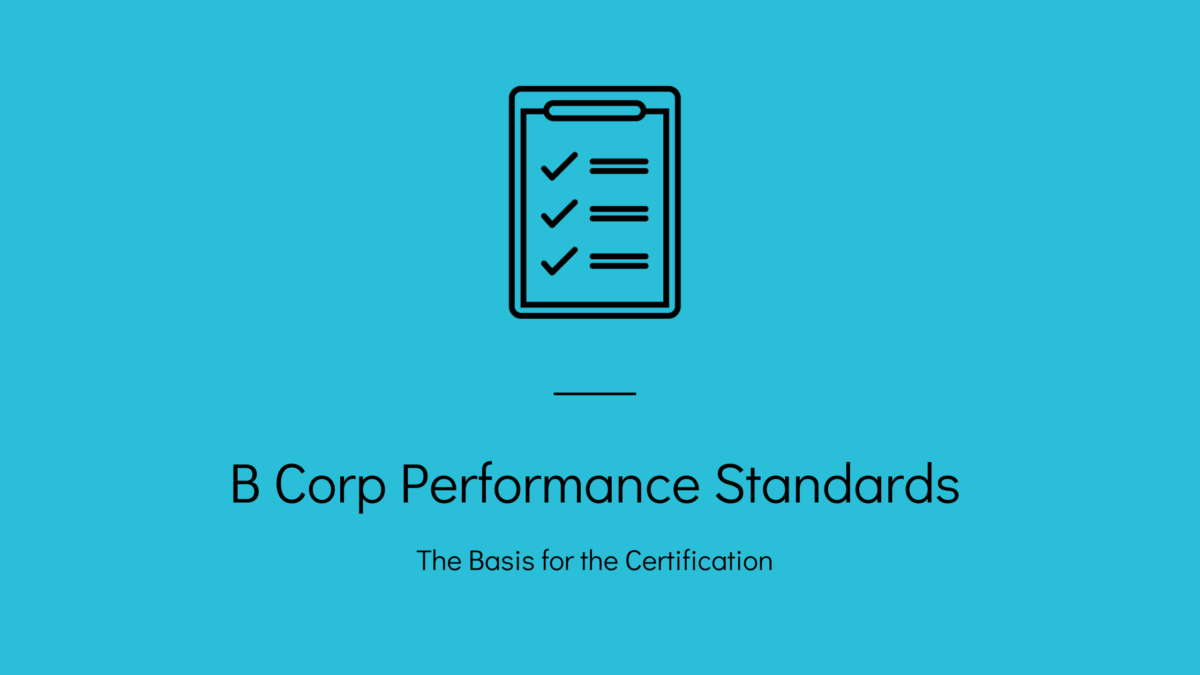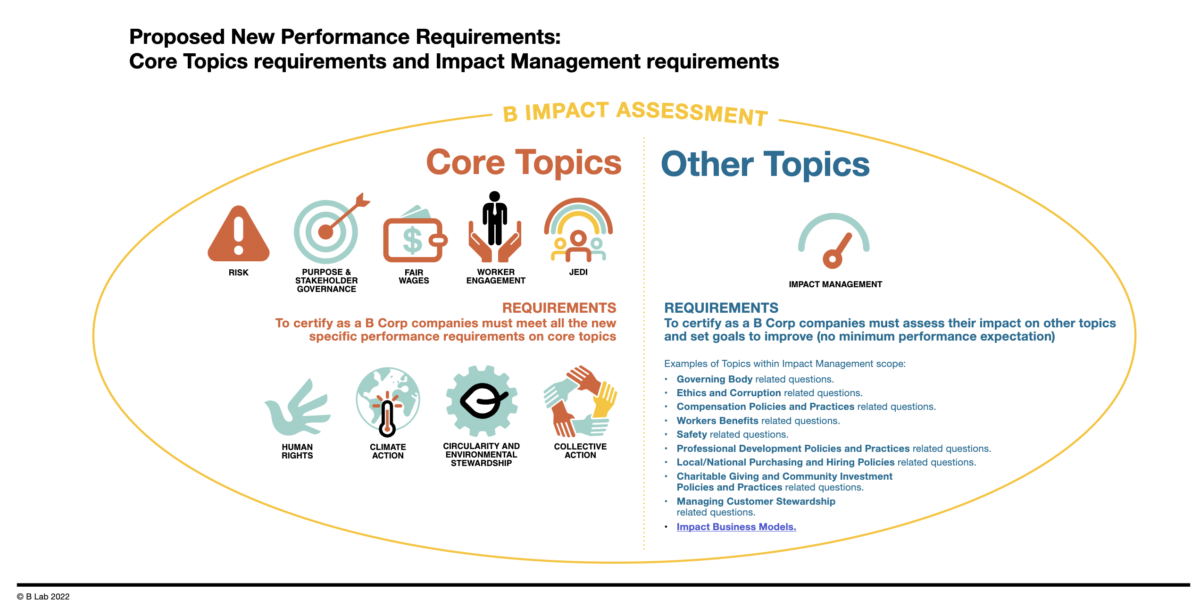
The B Corp Performance Standards are the heart and soul of the B Corp Certification. They capture the specific practices B Corps adopt to manage and improve their social and environmental impact. In effect, they represent those things that B Corps do that not all other companies do.
B Corp Performance Standards
Meeting the performance standards is one of the key B Corp certification requirements. The B Corp standards define the “social, environmental, and governance best practices for businesses,” and B Corps are required to demonstrate that they are meeting these high standards.
However, defining what actually constitutes those highest standards can be tricky. Best practices are constantly evolving; what was cutting edge a few years ago may now be expected of all businesses. Conversely, practices that may have been expected in the past may now be obsolete and completely irrelevant.
Because of this, the standards themselves must continually evolve. B Lab, the nonprofit behind the certification, has done this regularly by updating the B Impact Assessment (BIA), the online tool used to measure and manage impact. The BIA has been updated every three years, with version 6 being released in 2019. (The release of version 7 has been delayed to 2025 to align with the transition to new standards, which are explained below.)
Historically, companies have completed the BIA and earned points when they answer questions in the affirmative. Once a company earned 80 points, it became eligible for B Corp certification.
Changes to the B Corp Performance Standards
The B Corp performance standards are now going through a significant overhaul. Rather than allowing companies to pick and choose which practices they will (or already have) put in place via their answers on the BIA, B Lab will now require that all companies meet baseline requirements in 10 key areas.
This is a significant shift in the standards, as it means that if a company does not meet specific requirements, it cannot get certified; that had not been the case in the past.
B Lab has compelling reasons for making this change, recognizing that it will improve the movement’s collective impact (by harnessing the power of all B Corps towards specific outcomes) and provide clarity around what it means to be a B Corp (by clearly articulating those desired outcomes on behalf of the community).
These are the 10 categories, along with their desired outcomes, that B Lab has identified:
- Purpose & Stakeholder Governance: B Corps act in accordance with a defined purpose contributing to the creation of an inclusive, equitable, and regenerative economic system for all people and the planet.
- Worker Engagement: B Corp workers feel engaged. There is two-way communication and workers’ views are respected.
- Fair Wages: B Corp workers can afford a decent standard of living for themselves and their families, and there is wage equality among the workforce.
- Justice, Equity, Diversity & Inclusion: B Corps have inclusive and diverse work environments and contribute meaningfully to just and equitable communities
- Human Rights: B Corps treat people with dignity and respect their human rights.
- Climate Action: B Corps take action in accordance with science to combat climate change and its impacts.
- Circularity and Environmental Stewardship: B Corps demonstrate environmental stewardship and contribute to the circular economy in their operations and value chain, minimizing any negative impact and pursuing positive impact.
- Collective Action: B Corps play a leadership role in fostering shared understanding, solutions, and implementation towards an equitable, inclusive, and regenerative economy.
- Impact Management: B Corps comprehensively identify and measure the impacts of their business and improve upon them over time.
- Risk Standards: B Corps avoid, manage, and/or effectively respond to specific potential negative impacts associated with specific industries or practices, as well as existing or emergent concerns from their stakeholders.
Collectively, these new areas comprise the “Core Topics” that B Lab is introducing, along with specific requirements for meeting each one.

Five Steps to Prepare for the New Performance Standards
Preparing for the release of the new performance standards is a bit tricky for the simple reason that we don’t know yet exactly what the final requirements will be. The requirements themselves are still undergoing public review, and the guidance around how they will be verified has yet to be developed.
However, we do know that they are coming, so we recommend preparing for them. Here are steps that any company can take right now.
1. Familiarize yourself with the new standards
Review the new standards proposed by B Lab and provide feedback. The standards now include specific proposed requirements for each Core Topic. For example, proposed requirements for Fair Wages are that B Corps must pay living wages to their workers, take meaningful action to reduce wage disparities, and take meaningful action to ensure that workers in their supply chain are paid living wages. The draft standards include detailed information about how to meet these requirements, along with resources to guide that implementation. Each of the new Core Topics now has similar detailed guidance.
2. Inform others in your company about the new standards
Everyone within the company is a stakeholder who should be aware of the upcoming changes, regardless of whether they are actively involved in contributing to your overall impact strategy and BIA score or not. Be sure to communicate with your leadership team and other stakeholder groups that may need to be involved in any planning activities as a result of the new standards. Inform the rest of the company about the standards, how they might uniquely impact your company, and why they are important for B Corps to consider now.
3. Organize your B Team
Your B Team is a group of key stakeholders and internal partners who fill various roles in support of the company’s journey as a B Corp. They execute on initiatives, build momentum within the company, and support with certification and recertification. If this team is not yet assembled, begin organizing your B Team and establish a regular meeting cadence. If you haven’t met in a while, this is a good time to reconvene to discuss the new performance requirements.
4. Review your current performance in each Core Topic
If B Lab were to adopt these as final standards, how would your company do? You might find that as a B Corp, you’re already doing well in some areas, which would be great! Or, you might find that you’re not doing so well in most of these areas, which is fine, too – you have room to improve! Some requirements might reflect changes that you’ve considered making anyways, or perhaps changes that you haven’t yet considered but that could be worthwhile for your company. At the very least, they will present opportunities for thoughtful internal discussion about tangible ways to improve your own company’s impact.
5. Make an improvement plan
After reviewing your current performance, make a plan for how you will improve in each of the Core Topics. Note that they have not yet been finalized, so these requirements may change as B Lab continues through the feedback and testing process. To be fair, though, many of them are worth pursuing by companies that want to use business as a force for good, regardless of whether they are ultimately adopted as final requirements. Be sure to discuss your suggestions for improvement with your B Team and other stakeholders and consider incorporating these initiatives into your strategic planning and budgeting exercises. This will ensure that resources are available and that improvement initiatives are aligned with overall company goals.
How will you meet the performance standards?
Complete the form below to find out how we can help your company become a B Corp.